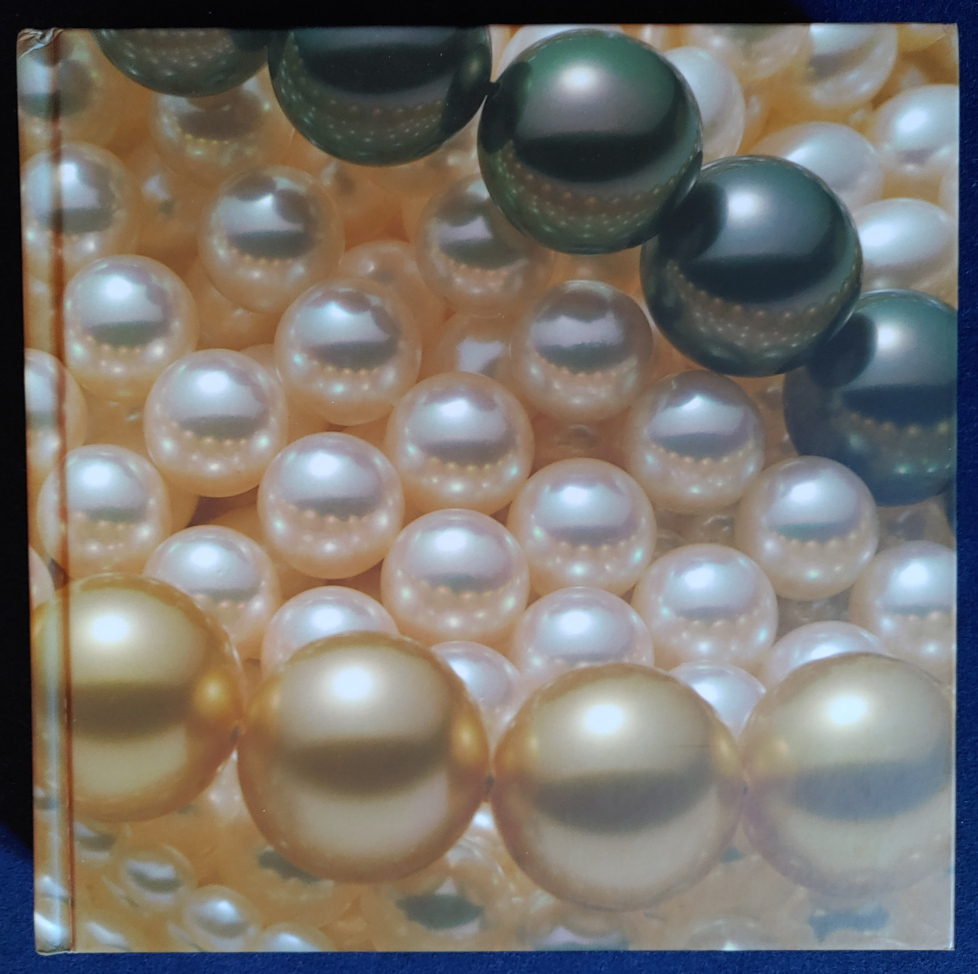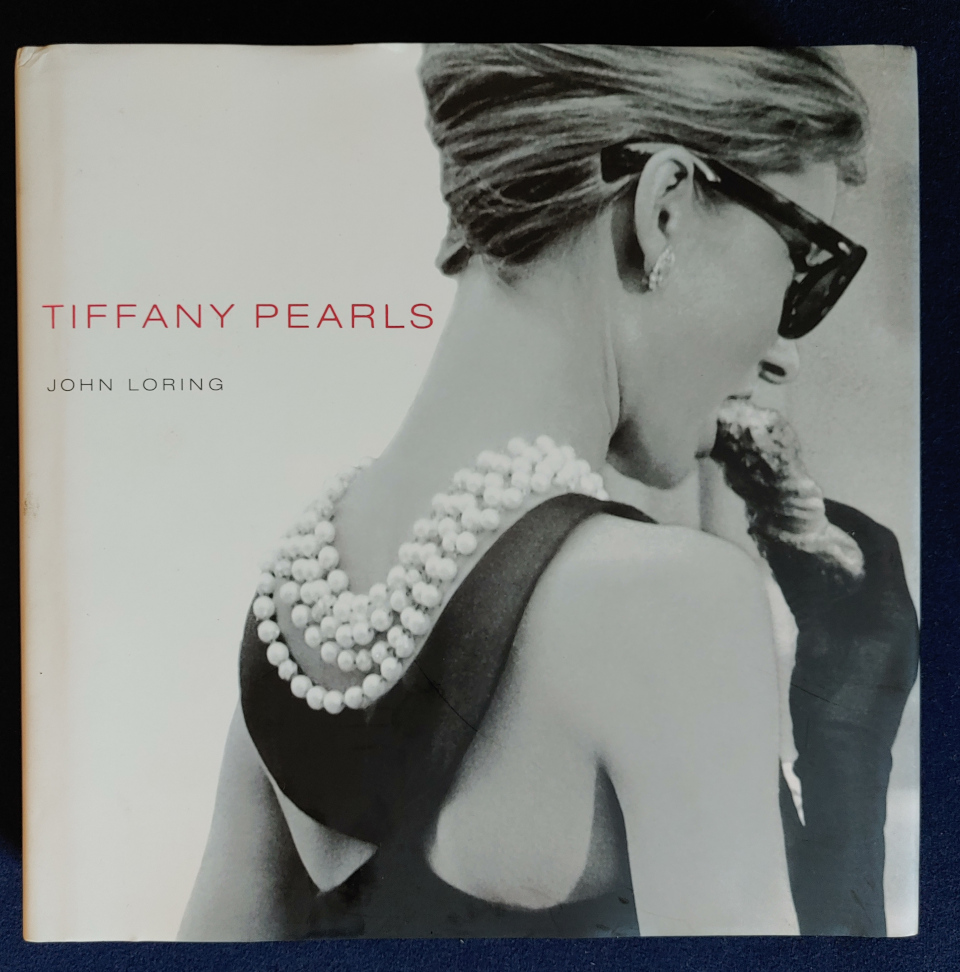Back in 2007, when big bookshops where still around everywhere, I found „Tiffany Pearls“ on my first trip to New York, bought it and carried it home. It is not a small book, it is a coffee-table-book, but it was too beautiful to leave it in New York. Amazon was not yet as strong as it is today and I couldn’t be sure to find it online.
On first sight I fell in love with Pearls through that book. I had been in China the year before and it was the time of the ascent of the Chinese pearl industry which is dominant today. Guided by a friend to a trustworthy source, I spent half a month’s salary on my first real pearls. Some South Sea pearls, some Freshwater.
This book was the first jewellery art book I bought. John Loring, design director of Tiffany & Co, started a whole series of books about the beautiful gems of his employer, and checking dates in the other ones I own (I have the whole series!) at least the one about Diamonds was earlier published than the Pearl one.
The dust jacket cover picture shows the famous movie scene with Audrey Hepburn outside Tiffany’s, gazing wistfully at the jewels. But focus here is on her pearl necklace, it has centre attention. Actually, the Pearl necklace is not made of real pearls. I was once about to buy a Kenneth Jay Lane copy, but didn’t, because it was so big and so clearly fake pearls. In the movie and on the cover photo it does fit the moment perfectly, but in the real world it can easily look something between strange and cheap.
The Tiffany Pearl book is very readable through all the anecdotes about Tiffany’s famous customers, stories behind jewels, artists and designers who developed breath-taking collections and so forth. Almost every page has at least one picture – a feast for the eyes. Don’t expect to learn too much about pearls and the different species. The book is not scientific, although everything in there is certainly true, but more to give the reader a feeling and a lust for pearls.
I love the picture on the cover without dust jacket. Here we see dark Tahitian pearls, coming from the shell „pinctada margaritifera“, white and golden South Sea pearls, coming from the shell „pinctada maxima“ and white Acoya pearls, coming from the shell of „pinctada martensii“. All of them are salt water pearls and famous for their lustre, if of the highest quality.

If you ever have asked yourself why there is such a price difference between pearls and also the sizes and colours seem to be abundant, let us look at some of the general rules. After falling in love with pearls, I read and learned abundantly about them.
Here comes the essence of pearl wisdom:
Natural pearls are nature’s freaks. It is so incredibly rare a shell bears a pearl without being pushed towards it by man, that pearls for centuries were more expensive than gold or diamonds. Onyl kings and queens owned and wore pearls. Today very few pearl fishers are still around. For centuries finding a pearl was a matter of luck and opening (killing) thousands of shells before discovering one. They could be found in rivers, in the sea and in lakes. A few pearls, like the pink conch pearl, even today cannot be cultured. Of course, that makes them very rare and very pricey.
The shells of Tahitian pearls and also South Sea pearls, coming from pinctada margaritifera and maxima respectively, can become up to 30 cm. Therefore, the pearl in that shell can – in exceptional cases – reach 25mm and more. From each Tahitian and South Sea pearl shell comes only 1 pearl at a time and the shells can only be used few times for bearing new pearls. One can never be sure a shell bears a pearl, even if all shells are treated the same – they are given a little injury and a seed in an operation. Afterwards, they are brought to waters with the right temperature and stay for at least 2 years. Then they are opened and it is always a surprise for the pearl farmer which one really bears a pearl and which size it has. Pearl farming is still a very natural business. You can’t try it in a place that the pearls don’t like.
Akoya pearl shells are much smaller. The pearls can only grow up to appr. 10-11mm due to the smaller size. The Japanese, who invented pearl farming (maybe you know the name Mikimoto? Mr. Mikimoto was the pioneer of pearl farming), started to work with that shell around 1900. In 1920 cultured pearls, as they are known, took over the pearl industry. Whilst in the beginning all the experts had looked down and bashed the cultured pearls, with increasing quality the customers didn’t care and of course demand made the decision for cultured pearls.
We have seen a similar reaction of experts when Chinese Freshwater pearls came to the market. In the beginning, in the 1980 and 1990, indeed the „rice pearls“ or „potato shaped pearls“, cheaply dyed, looked a bit pitiful for obvious reasons. They were trashed by experts, but curiously looked at by consumers. The ambitious and hardworking Chinese mastered all problems with the years. Now look at the Chinese pearl farming industry today! … Colours, sizes, species – top of the world. The big difference to saltwater pearls is that the Freshwater pearl shells „Hyriopsis cumingii“ contains many pearls, not only 1, they can contain easily 20 pearls. The shell is big, appr. 30 cm, does not need clear water, the pearls come naturally in various colours and shapes – that makes it really grateful to the farmers and consumers. With bigger output the prices get better for consumers as well.
One can insert beads in the shells of Freshwater pearls, the same as one does with saltwater shells, and the difference to white and golden South Sea pearls is only seen by experts. If you have the chance to compare a white South Sea pearl necklace of the best quality with one of the best quality from Freshwater pearls one to one, you can see the difference. The lustre of the South Sea pearls will be better. Most people, though, can only afford mediocre or good South Sea pearls and trust me, the lustre of a great Freshwater pearl necklace tops that by far. One might also take into consideration that few people come so close to a lady’s neck and have nothing better to do and have the knowledge as to comment on the pearl quality…
My personal favourites pearls are the Chinese Kasumi look alikes. The pearls from the Japanese Kasumigaura lake have a metallic lustre in all the rainbow’s colours. Naturally. Breathtakingly. They come from the shell of „Hyriopsis schlegelii“ and are bead induced. I prefer the Chinese ones to the original ones from the Kasumigaura lake, because price differs by appr. one „0“. You pay 600-1000€ for a really beautiful Chinese one and 6000-10.000€ for a really nice Japanese one from the lake. What can I say? One day I want a Japanese one, too.
When you do not own any pearls yet, I would recommend you start at your local jeweller (even Tiffany!). You might pay a bit more but if you ask nicely, they will show you different kind of pearls. You can also buy online at some jewellers. I do not recommend to buy online directly from Chinese or any other foreign stores when you are a rookie in pearls (and in import taxes and customs, that is). That goes for pearls as for everything else. Start slow, do your research, start to buy pearls, compare various pearls species, check out the local merchandise on holiday. Actually, I bought online from the beginning, with very varying results. Best advice: make you first order at any shop you try for the first time never a really expensive one, no matter how good the customer service is. With a little knowledge you will mature to the good online stores from alone.
I made good experiences online eg. with Perlenforum (GER), Catherine Cardellinis store (AUS), Tahitian Pearls Biz (USA), Manapearl (Tahiti), Pacific Pearls USA and Kojima Pearls (USA), due to the pearl types I looked for. There are many, many more great online stores outside there and searching through them is very worthwhile.
If you want to see if you like pearls in general, to start with the Tiffany book is a smart move. After all the years is it still the book with the nicest pearl pictures in my opinion.
Ah, and another practical advice. If you are new to pearls and think about buying a necklace at some market or a jeweller, and you cannot yet see if the pearls are fake or real, you will note the difference when bringing them shortly to your teeth, or less irritatingly for the seller, to your unpainted nails. Rub them softly back and forth. Real pearls leave a slightly sandy feeling, whilst fake ones (eg Majorica pearls) feel just like plastic.
All rights to the book belong to:
Loring, John: Tiffany Pearls, Copyright Tiffany & Co 2006, an imprint by Harry B. Abrams, Inc, 115 West, 18th Street, New York, N.Y. 10011, Printed and bound in Japan, ISBN 0-8109-5443-5

